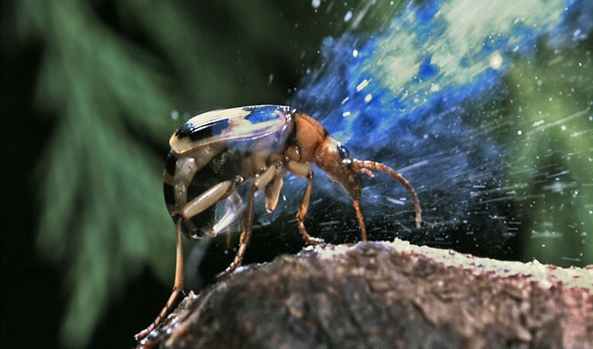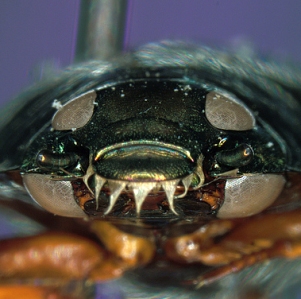| Bogleech Presents The Top Twenty Coolest Beetles |
| #16 - Mormolyce - the Violin Beetles |
Carabids or "ground beetles" are a large and diverse group, usually predatory and adapted to a wide range
of environments. There are only four species of these particularly strange looking Carabids, inhabiting the
tropical forests of Indonesia, Malaysia, Borneo and Thailand. Their extremely flat bodies allow them to slip
under tree bark and other tight places in pursuit of prey, and their long, thin heads can reach into the tunnels
of wood-boring insects. When Mormolyce phylloides is disturbed, it ejects butryic acid, capable of paralyzing
human fingers for more than a day.
of environments. There are only four species of these particularly strange looking Carabids, inhabiting the
tropical forests of Indonesia, Malaysia, Borneo and Thailand. Their extremely flat bodies allow them to slip
under tree bark and other tight places in pursuit of prey, and their long, thin heads can reach into the tunnels
of wood-boring insects. When Mormolyce phylloides is disturbed, it ejects butryic acid, capable of paralyzing
human fingers for more than a day.
| #14 - Xyleborus - Ambrosia Beetles |
These incredibly tiny, snoutless members of the Weevil family are a rare example of a fully social beetle and
one half of a sophisticated symbiotic partnership. The adult beetles typically excavate tunnels or "galleries" in
dead or dying wood, not to feed upon the wood directly, but to cultivate wood-digesting ambrosia fungus,
which constitutes their entire diet and extracts all the nutrients they need from the surrounding tree. Both
beetle and fungus are entirely dependent upon one another for existence, with special pouches on the
insect's body adapted to collect and transport fungal spores to new trees.
One species of ambrosia beetle, Austroplatypus incompertus, is the very first beetle to ever be recognized as
eusocial, meaning that it forms colonies of specialized castes like those of ants, bees and termites, including
both reproductive and non-reproductive roles.
one half of a sophisticated symbiotic partnership. The adult beetles typically excavate tunnels or "galleries" in
dead or dying wood, not to feed upon the wood directly, but to cultivate wood-digesting ambrosia fungus,
which constitutes their entire diet and extracts all the nutrients they need from the surrounding tree. Both
beetle and fungus are entirely dependent upon one another for existence, with special pouches on the
insect's body adapted to collect and transport fungal spores to new trees.
One species of ambrosia beetle, Austroplatypus incompertus, is the very first beetle to ever be recognized as
eusocial, meaning that it forms colonies of specialized castes like those of ants, bees and termites, including
both reproductive and non-reproductive roles.
| #13 - Platypsyllus - Beaver Beetles |
Eyeless, wingless and smaller than a pinhead, these beetles closely resemble fleas because they, too, live in
the fur of mammals - specifically beavers. Unlike fleas, however, these "beaver bugs" are harmless and
perhaps even hygenic to their hosts, feeding only upon dead flakes of skin, mites and other contaminants in
beaver fur. Few other beetles are so heavily adapted to the body of another animal, and thus far, these
seldom-seen weirdos have been found living on virtually no other type of mammal.
the fur of mammals - specifically beavers. Unlike fleas, however, these "beaver bugs" are harmless and
perhaps even hygenic to their hosts, feeding only upon dead flakes of skin, mites and other contaminants in
beaver fur. Few other beetles are so heavily adapted to the body of another animal, and thus far, these
seldom-seen weirdos have been found living on virtually no other type of mammal.
| #12 - Gyrinidae - the Whirligig Beetles |
Many beetles are known for their amphibious habits, but the Gyrinidae are adapted unlike any other insect to
a life half-submerged at the water's surface, suspended perfectly by surface tension where they buzz about
like miniature motorboats. A whirligig beetle's four paddle-like rear legs beat up to sixty times a second to
propel it at high speeds, while the foremost pair of limbs are adapted into a set of gripping claws, used to
prey upon insects that fall into the water. Highly unusual are the beetle's eyes; a single huge pair run all the
way through the head to protrude out both the top and bottom, giving the appearance of four separate eyes
while giving the insect an equally detailed view of the sky above and water below.
a life half-submerged at the water's surface, suspended perfectly by surface tension where they buzz about
like miniature motorboats. A whirligig beetle's four paddle-like rear legs beat up to sixty times a second to
propel it at high speeds, while the foremost pair of limbs are adapted into a set of gripping claws, used to
prey upon insects that fall into the water. Highly unusual are the beetle's eyes; a single huge pair run all the
way through the head to protrude out both the top and bottom, giving the appearance of four separate eyes
while giving the insect an equally detailed view of the sky above and water below.
| Written by Jonathan Wojcik |
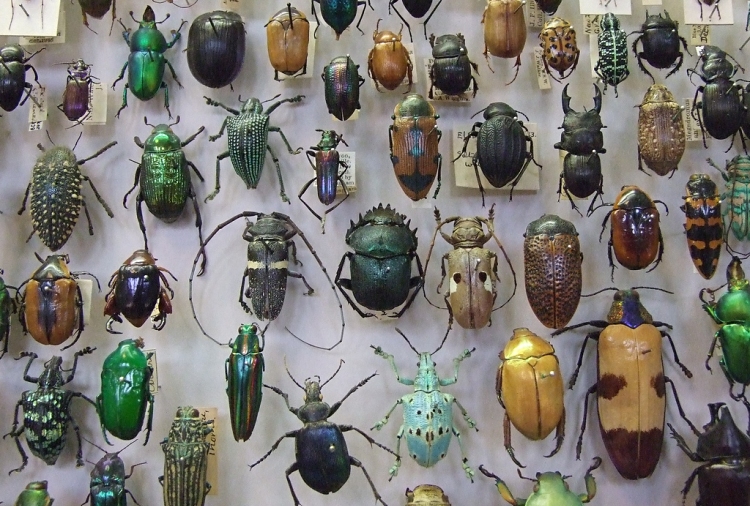
| Photo by Sparks68 - taken at the Oxford Natural History Museum |
The order Coleoptera (sheath-winged) or "beetles" are not only the largest order of the class Insecta, but the
largest order of animal life by a staggering margin. Nearly half of all known insects are some variety of beetle,
constituting roughly a quarter of all life as we know it - and hundreds of new beetles are discovered every
year. To put this in perspective, there are more named species of weevil alone than every fish, amphibian,
reptile, bird and mammal on our planet put together, and weevils are just one of the many families and
superfamilies comprising the Coleoptera. So what exactly defines a beetle?
largest order of animal life by a staggering margin. Nearly half of all known insects are some variety of beetle,
constituting roughly a quarter of all life as we know it - and hundreds of new beetles are discovered every
year. To put this in perspective, there are more named species of weevil alone than every fish, amphibian,
reptile, bird and mammal on our planet put together, and weevils are just one of the many families and
superfamilies comprising the Coleoptera. So what exactly defines a beetle?
| #15 - Scarabaeinae - the Dung Beetles |
Revered in ancient Egypt, the Scarabaeinae are famous for their habit of rolling animal droppings into
spheres. This is primarily performed by the male, whose dung-ball is both an advertisement of his manhood
and a future nursery for his offspring. The female may assist in rolling the ball far away from competitors or
simply ride along while her mate does all the work. Picking out a prime spot, they load up the dung-ball with
eggs and sometimes bury themselves with it to watch over the larvae.
As competition for Mother Nature's special brownies can naturally get pretty fierce, some species don't even
wait for it to hit the ground; they'll happily camp out for hours to get pieces of crap straight from the source,
much like otaku.
spheres. This is primarily performed by the male, whose dung-ball is both an advertisement of his manhood
and a future nursery for his offspring. The female may assist in rolling the ball far away from competitors or
simply ride along while her mate does all the work. Picking out a prime spot, they load up the dung-ball with
eggs and sometimes bury themselves with it to watch over the larvae.
As competition for Mother Nature's special brownies can naturally get pretty fierce, some species don't even
wait for it to hit the ground; they'll happily camp out for hours to get pieces of crap straight from the source,
much like otaku.
Another, possibly weirder dung beetle is Zonocopris gibbicollis, which lives only on the bodies of giant African
snails to feed on the host's feces. Please thank - and visit! - Kabinet of Curiosities for drawing my
attention to this.
snails to feed on the host's feces. Please thank - and visit! - Kabinet of Curiosities for drawing my
attention to this.
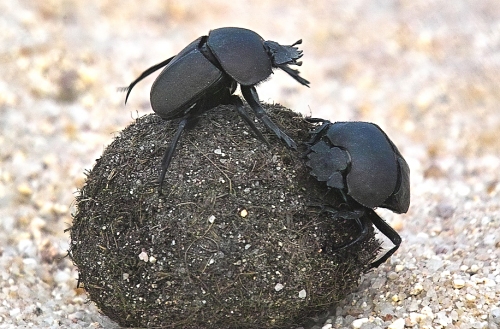
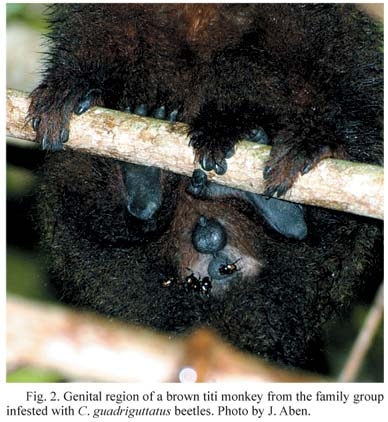
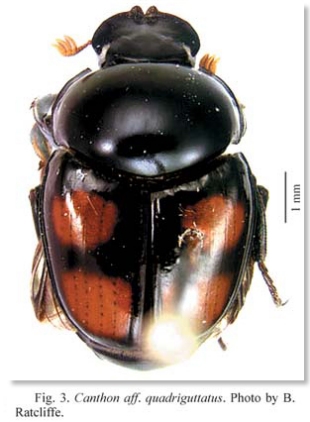
| Photo Credit: Jacobs et al. 2008. Neotropical Entomology 37(6):641-5. |
Yes, some species just cling tenaciously to the buttocks of large mammals such as this titi monkey, waiting for
the next steamy bus ride to the forest floor. When their host begins defecating, the beetles simply hop
aboard the droppings and hang on for dear life, guaranteeing themselves first dibs on one of insectkind's
hottest commodities.
the next steamy bus ride to the forest floor. When their host begins defecating, the beetles simply hop
aboard the droppings and hang on for dear life, guaranteeing themselves first dibs on one of insectkind's
hottest commodities.
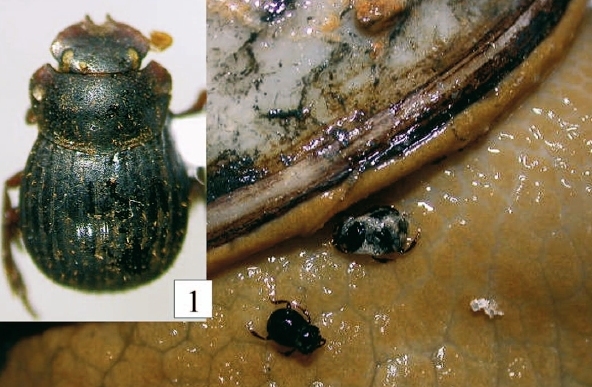


| Photo from Butterfly Designs - real specimens for sale! |
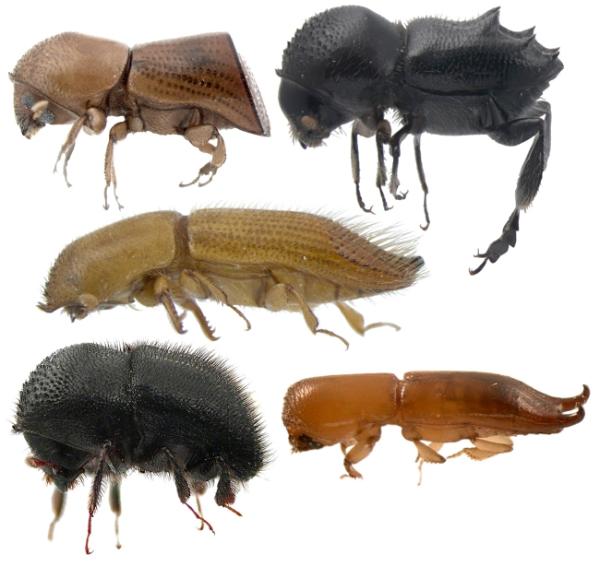
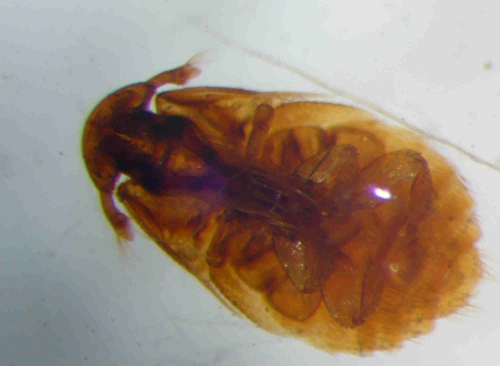
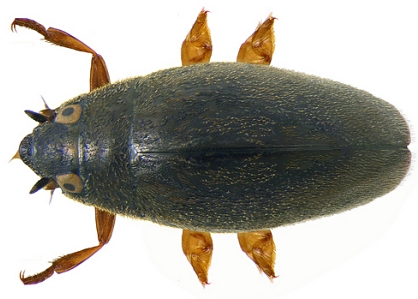
Gyrinidae have a natural drive to gather in large numbers that appear at first glance to exist in total chaos,
with dozens of individuals zipping and whirling about one another at incredibly high speeds. Like cells in a
brain, the insects are actually communicating non-stop to maintain perfect order, with a specific placement in
the group for each individual.
with dozens of individuals zipping and whirling about one another at incredibly high speeds. Like cells in a
brain, the insects are actually communicating non-stop to maintain perfect order, with a specific placement in
the group for each individual.
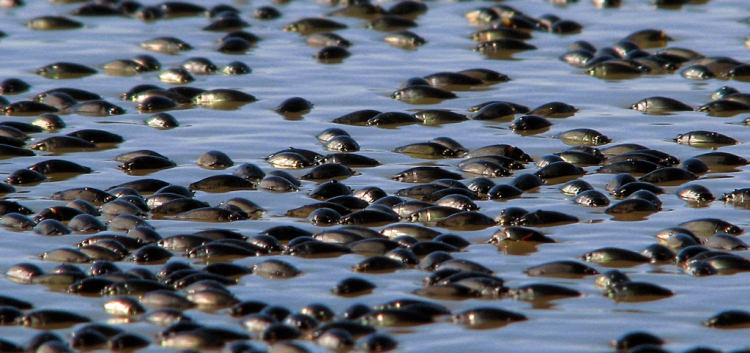
| #11 - Brachinidae - the Bombardier Beetles |
| Photo from the BBC |
Combined together, the volatile ingredients reach nearly boiling temperatures and build pressure until they
"flash evaporate," exploding from a specialized opening near the anus in a burst of searing hot, vile smelling
and vile tasting vapor. The entire process - from frightened beetle to killer gas attack - is so instantaneous
that it can repeat several hundred times in a fraction of a second, appearing as a single blast to the human
eye, and its highly flexible abdomen allows it to aim the explosion in almost any direction.
"flash evaporate," exploding from a specialized opening near the anus in a burst of searing hot, vile smelling
and vile tasting vapor. The entire process - from frightened beetle to killer gas attack - is so instantaneous
that it can repeat several hundred times in a fraction of a second, appearing as a single blast to the human
eye, and its highly flexible abdomen allows it to aim the explosion in almost any direction.
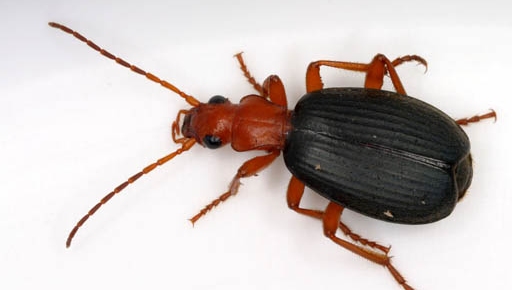
These carabids don't look that unusual or dangerous on the outside, but that mistake has probably left
mental scars on millions of insect-eaters. Housed within the abdomen of a brachinus beetle are two separate
chemical compounds; hydrogen peroxide and hydroquinone. When it feels threatened enough, the insect
empties the two chemicals into a "mixing chamber" of water and special catalytic enzymes...
mental scars on millions of insect-eaters. Housed within the abdomen of a brachinus beetle are two separate
chemical compounds; hydrogen peroxide and hydroquinone. When it feels threatened enough, the insect
empties the two chemicals into a "mixing chamber" of water and special catalytic enzymes...
